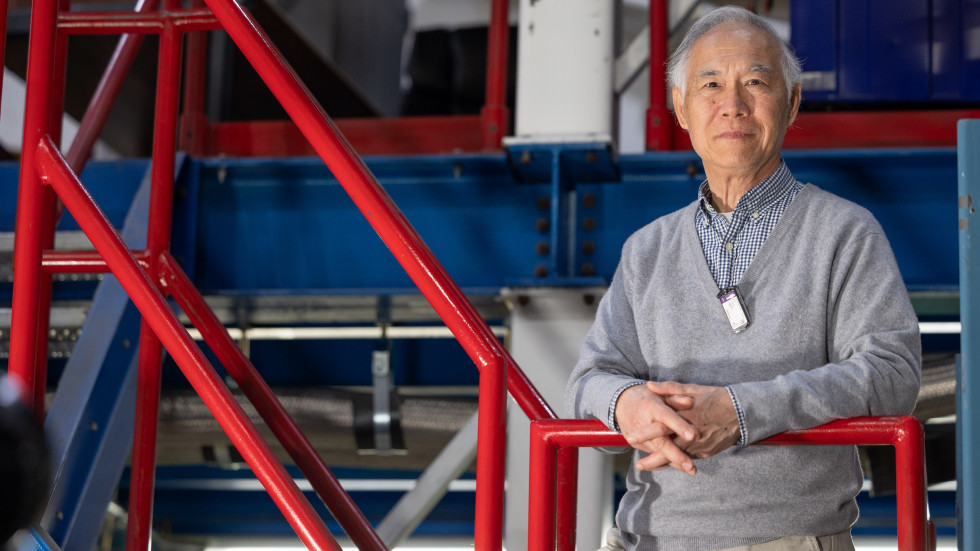Jefferson Lab photo by Lindsay Cunningham
Jefferson Lab and Hampton University offer unique opportunities for research collaboration
NEWPORT NEWS, VA – From assembling furniture and airplane models to building telescopes so he could see the stars, Liguang Tang’s hands have been in constant motion, a trait his father always encouraged.
For more than three decades, Tang has held a joint position as a senior staff scientist at the U.S. Department of Energy's Thomas Jefferson National Accelerator Facility and a physics professor at nearby Hampton University. This unique role provides an opportunity to balance research and mentorship.
Tang's simple yet powerful curiosity, evident in his childhood question, “What can I build next?” laid the foundation for his research in experimental hypernuclear physics. His work has significant implications for understanding the universe's fundamental forces and structures and has helped close gaps in our knowledge of hyperons, neutron stars and particle interactions.
“When I started hypernuclear research, I had to design everything from scratch:, spectrometers, detectors, and experiments. It wasn’t easy, but it was worth it to pioneer this field,” he said.
Tang describes his study of hypernuclear physics, which examines how the building blocks of atoms are held together by studying rare particles called hyperons, as a family.
This simple analogy describes the hyperon as the newest family member, created during high-energy collisions, such as those with existing family members - neutrons and protons.
“When you introduce a new member into your family, you want to know how this member will interact with the other members,” explained Tang. “Are they happy? Do they understand and follow the rules of interaction, such as no phones at dinner? Or, in the case of particle physics, do they follow the universal rule of symmetry?”
Obtaining this knowledge is incredibly challenging because the hyperon's lifespan is extremely short, and the hyperon joins the nuclear family for only a fraction of its short lifespan!
Imagine that with the use of a particle accelerator to study the dynamics of this family, we can only observe the hyperon for about 200 picoseconds; in the time it takes to blink once, 200 picoseconds could happen hundreds of thousands of times!
The research Tang and his students conduct from these short glimpses help scientists better understand the forces that bind matter, unlocking new knowledge about how the universe works. Their work not only answers fundamental questions about the nature of matter, but also has the potential to impact fields like astrophysics, helping us explore everything from the tiniest particles to the vastness of space, right up to the stars that Tang has always wanted to see.
“My work at Jefferson Lab has given me hands-on experience with advanced experimental techniques and data analysis, critical in academic and industrial STEM fields,” said Ravindu Kumaragamage, Hampton University Ph.D. student conducting research with Tang at Jefferson Lab. “Beyond the technical aspects, working in such a dynamic environment has enhanced my ability to manage complex tasks and collaborate effectively, skills that will serve me well in any setting.”
Beyond the research, Tang’s belief in the future of scientific advancement emphasizes the critical role of mentorship, offering his students invaluable experience and training through his leadership.
“Dr. Tang’s mentorship has fundamentally shaped my approach to both problem solving and collaboration. He encourages asking the right questions, breaking problems into manageable parts; and thinking critically about potential solutions,” said Kumaragamage.
The partnership between Jefferson Lab and Hampton University demonstrates the power of collaboration and the opportunities that arise with shared resources.
“You cannot rely solely on the lab’s resources,” said Tang. “University faculty bring creative brainpower, and students gain hands-on experience, becoming the next generation of thinkers and doers.”
Further Reading
Dr. Liguang Tang Bio - School of Science
Contact: Michelle Alvarez, Jefferson Lab Communications Office, malvarez@jlab.org


